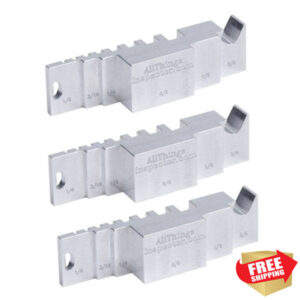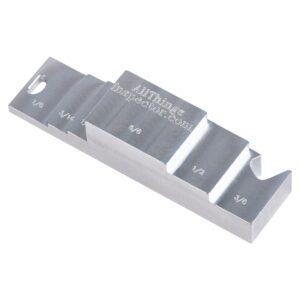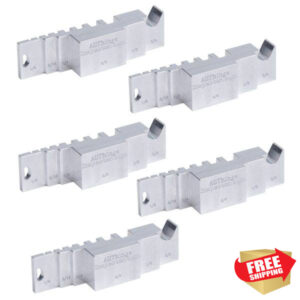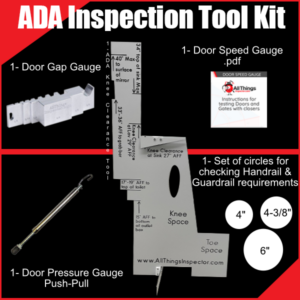Door Gap Gauge
What is a Door Gap Gauge?
The Door Gap Gauge is a simple tool that makes examining a door quick as well as straightforward.
This highly efficient device is an “essential” product for every single door carpenter, fire marshal, AHJ/IOR, maintenance supervisor, and fire department needs in their toolbox. Its compact design allows you to quickly and accurately confirm compliance.
Our door gap gauge was made with input from fire marshalls, building owners, and door carpenters.
The result is a tool that’s more accurate than a tape measure, user-friendly, and affordable. These factors have helped the door gap gauge from All Things Inspector gain popularity, as well as you can find them being used throughout the USA.
What if my business is tax exempt?
Some of our door gap garage Clients Include















See Our Extensive Inventory
-
Sale!
Inspection Tool Kit
$349.00Original price was: $349.00.$299.99Current price is: $299.99. Add to cart -
Sale!
Door Inspection Tool Kit
$89.99 – $269.97 Select options This product has multiple variants. The options may be chosen on the product page -
Door Gap Gauge 4 Pack
$119.00 Add to cart -

Door Gap Gauge 3 Pack
$89.85 Add to cart
Buy Door Gap Gauges Online
With a single door gap gauge, you can examine the clearance of a door in seconds. The device more than pays for itself with the time it conserves workers who are examining door clearances. Plus, by making sure doors are within ADA standards, structure owners can prevent expensive charges for noncompliance. Building crews can use door space gauges to prevent problems that would need the team to come back to fix the doors.
You can purchase a single door gap gauge from All Things Inspector if it’s for a specific building inspector or home supervisor. You can also save cash by getting multipacks with in between 2 and six evaluates. A team of employees equipped with door gap gauges can rapidly examine all of the doors in a high-rise office, health center, apartment complex, or any facility that has numerous fire doors that require to be checked.
Watch this video to find out why this is the very best door gap gauge you can buy.
If you have a fire rated door that you need to inspect. You need to watch the video to see all the features the best door gap gauge boast.
How to Use a Door Gap Gauge
Watch this video to see how easy it is to use the best door gap measuring tool to check NFPA 80 compliance of a fire door.
Watch the video to see if the door gap is too big?
Watch the video to see if the door gap is too small?
If you have a fire rated door that you need to inspect. You need to watch the video to see all the features the best door gap gauge boast.
Guide to Maintain NFPA 80 Compliant Doors
At All Things Inspector, we are experts at developing materials that help construction crews keep up with fire door compliance.
We have actually produced the following list for property managers and building owners for keeping their doors within NFPA 80 compliance.
Step 1 – Find out what kind of door and frame you are inspecting to determine the required NFPA 80 requirements.
Door Requirements – For the Top & Vertical Edge
For Steel Doors
- For Steel Doors Swinging in sets the clearance between the top and vertical edges of the door, the frame, and the meeting edges shall be 1/8 ″– 1/16 ″.
For Wood Doors
- For Wood Doors Swinging in pairs the clearance in between the leading and vertical edges of the door, the frame, and the meeting edges will not surpass 1/8 ″.
Bottom of Door Requirements:
- The clearance at the underside of the bottom of a door and non-combustible surface shall not exceed 3/4 ″.
- The clearance under the bottom of a door and raised non-combustible sills will be an optimum of 3/8 ″.
Now that you know the clearance requirements you are trying to measure you will move on to Step 2.
Step 2 – Measure the door gaps. Keep in mind and note all clearance measurements on the pull side of the door so you can document them for your annual NFPA 80 inspection.
Measuring the Leading and Vertical Edge of Door Requirements:
Locate the portion of the fire door gauge with the dimension you are seeking to determine. Place the gauge in the palm of your hand. Then stick the door gap gauge in the gap at the door and between the frame. The gap gauge should fit accurately in the space between the door and the hollow metal frame, sliding along the whole length of the space along the leading and vertical edges.
Measuring the door bottom requirements with a:
- Grab your gauge, find the size you are looking to confirm and insert the gap gauge under the bottom of the door and take an accurate measurement.
Step 3 – Verify that your door gap gauge that the gaps fall within the clearances outlined by NFPA 80 and change as required.
Step 4 – If you still require some assistance we have a couple of how to use a door gap gauge videos that you can watch.
Step 5 – Download our free NFPA 80 Fire Door Inspection checklist that you can use on your projects.







